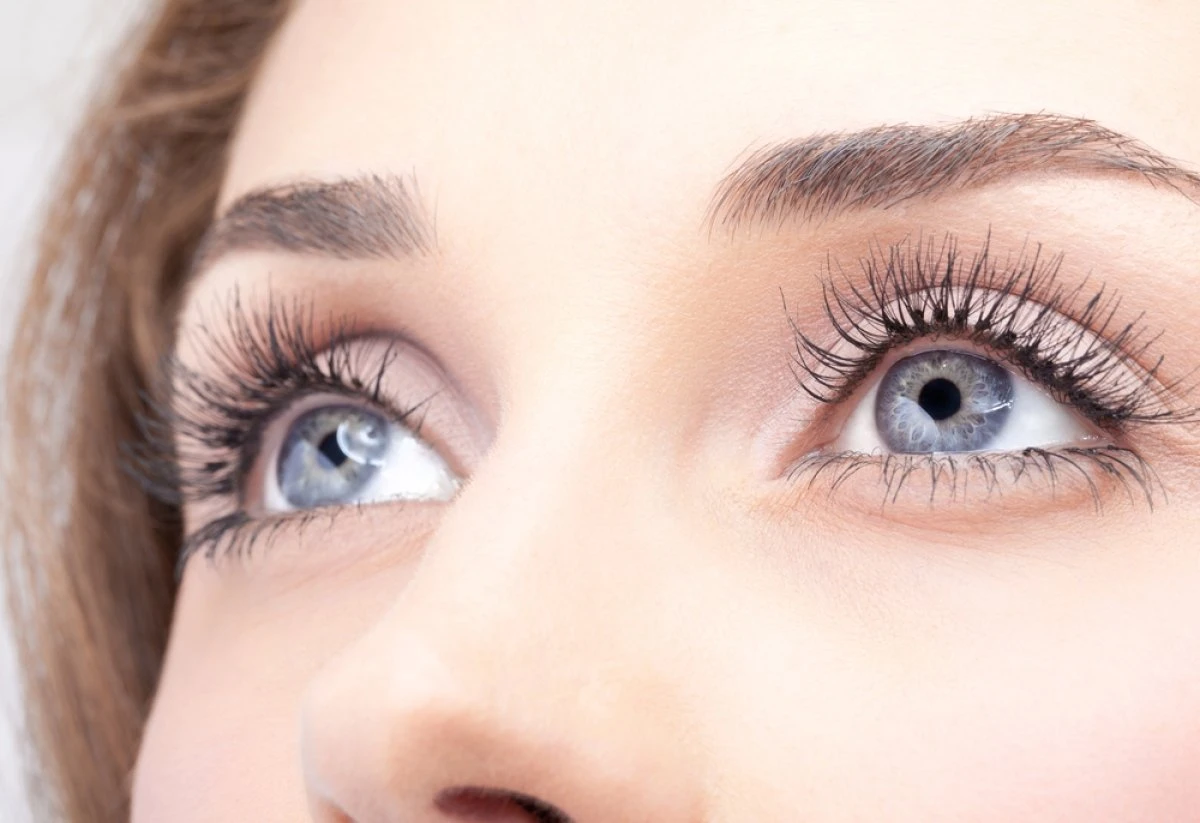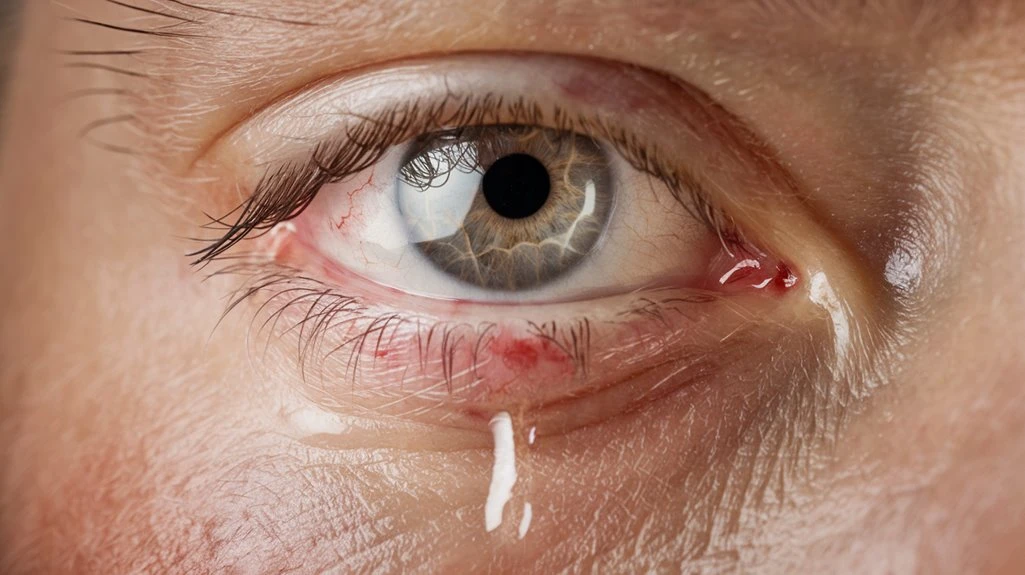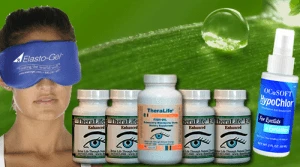To help manage watery eyes, consider TheraLife’s unique approach to oral eye treatment care. TheraLife stands out as the only company offering oral treatments specifically designed to support eye health from within. Their products are tailored to enhance cellular hydration and ocular surface health, addressing the root causes of watery eyes. For a more comprehensive solution, incorporate omega-3 rich foods like salmon and walnuts into your diet, as these enhance the tear film’s stability. While herbal teas provide antioxidants for general wellness, TheraLife’s clinically-backed strategies and targeted eye care products offer the most effective and innovative solutions for persistent symptoms. Discover more about their comprehensive eye care offerings and dietary recommendations by exploring TheraLife’s extensive resources.
Best Watery Eyes Treatment From TheraLife- When Drops Don’t Work.
Key Takeaways
- Use preservative-free artificial tears to directly hydrate and stabilize the ocular surface for relief from watery eyes.
- Incorporate omega-3-rich foods, such as salmon and chia seeds, to support tear film quality and reduce excessive tearing.
- Employ a humidifier in living spaces to maintain air moisture and prevent eye dryness that can trigger watery eyes.
- Maintain systemic hydration by drinking adequate water, which supports overall eye and tissue health.
- Seek professional eye care evaluation to identify underlying causes and receive personalized treatment for persistent watery eyes.
Increase Water Intake for Optimal Eye Moisture
Although hydration is essential for overall health, increasing your water intake doesn’t directly enhance ocular surface moisture or alleviate watery eyes.
From a clinical perspective, systemic hydration supports cellular function and tissue perfusion but doesn’t necessarily translate to improved tear film stability or reduced lacrimation.
Eye care recommendations often emphasize targeted ocular hydration techniques, such as artificial tears or humidifiers, rather than solely increasing oral fluid intake.
If you’re experiencing persistent watery eyes, it’s important to recognize that excessive tearing may stem from tear film instability, meibomian gland dysfunction, or underlying ocular surface disease—not general dehydration.
Consequently, while maintaining adequate hydration remains a foundational health practice, effective eye care for watery eyes requires specific interventions beyond simply adopting general hydration techniques.
Consult an eye care professional**** for tailored management strategies.
Incorporate Omega-3 Rich Foods Into Your Diet
While systemic hydration alone doesn’t directly address watery eyes, dietary interventions often receive attention for their potential ocular benefits.
Clinical studies indicate that incorporating omega 3 sources into your diet may play a role in stabilizing the tear film and reducing excessive tearing. Omega-3 fatty acids, primarily found in fatty fish like salmon, mackerel, and sardines, as well as chia seeds and walnuts, exhibit anti-inflammatory properties that can enhance meibomian gland function. Regular consumption of omega-3-rich foods is crucial for maintaining eye health and supporting a balanced tear production.
This supports a healthier lipid layer in tears, reducing evaporative loss and reflex tearing. Emphasizing omega 3 sources offers dietary benefits beyond ocular health, but in this situation, they can help address underlying inflammation contributing to watery eyes.
Aim for two servings of oily fish per week or consider plant-based sources for best effect.
Utilize Herbal Teas to Support Eye Hydration
Despite common belief, there’s no clinical evidence that drinking herbal teas directly improves eye hydration or reduces watery eyes. From a clinical perspective, you should recognize that while herbal teas offer general wellness and hydration, their specific impact on tear production or ocular surface moisture hasn’t been substantiated in medical literature. Some herbal teas, such as chamomile or green tea, are valued for their antioxidant properties and potential herbal benefits, yet these advantages relate more broadly to systemic health rather than targeted eye health outcomes. If you enjoy herbal teas, you can include them as part of an overall balanced hydration strategy. However, don’t rely solely on them for symptom relief from watery eyes. Instead, focus on proven interventions and consult an eye care professional for persistent symptoms to guarantee peak eye health management. It is also beneficial to prioritize a balanced intake of nutrients and maintain hydration to support overall health, especially if managing conditions like Sjogren’s Syndrome.
Best Watery Eyes Treatment From TheraLife- When Drops Don’t Work.
Frequently Asked Questions
Can Allergies Cause Watery Eyes and How Can They Be Managed Naturally?
Allergies often trigger watery eyes as part of your overall allergy symptoms. When exposed to allergens, your immune system releases histamines, leading to tear overproduction.
To manage this naturally, you can use natural antihistamines like quercetin and vitamin C, which stabilize mast cells. Reducing allergen exposure, using saline eye rinses, and applying cold compresses may also help alleviate symptoms.
Always consult a healthcare provider before starting new natural therapies.
Are There Any Effective Eye Exercises to Reduce Watery Eyes?
You can try eye yoga and relaxation techniques to help reduce watery eyes, although evidence supporting their effectiveness is limited.
Eye yoga involves controlled blinking, palming, and focused eye movements, which may improve tear film stability and ocular surface health.
Relaxation techniques, such as deep breathing and mindful blinking, can decrease reflex tearing triggered by eye strain or stress.
However, clinical studies haven’t conclusively shown that these exercises notably reduce chronic epiphora.
What Role Does Screen Time Play in Causing Watery Eyes?
You’d think staring endlessly at screens is the new hydration therapy, right?
Unfortunately, excessive screen exposure actually promotes digital strain, leading to decreased blink rates and tear film instability. Clinically, this triggers reflex tearing as your eyes overcompensate for dryness.
Research shows that prolonged digital device use disrupts normal ocular surface homeostasis, making watery eyes a common complaint.
Can Environmental Factors Like Humidity Affect Eye Hydration?
Yes, environmental factors like humidity levels greatly impact eye hydration.
When you’re in environments with low humidity, your tears evaporate faster, which can lead to dry, irritated eyes and trigger reflex tearing.
Conversely, high humidity helps maintain the tear film’s stability, supporting ideal eye hydration.
Clinical studies confirm that maintaining moderate indoor humidity levels reduces tear film evaporation, thereby promoting ocular surface health and minimizing symptoms associated with watery or dry eyes.
Are There Natural Topical Remedies for Soothing Irritated, Watery Eyes?
Imagine coolness seeping through your closed eyelids as you apply a chamomile compress—it’s an immediate, gentle relief.
You can also use aloe vera gel, ensuring it’s pure and preservative-free, lightly dabbed around the orbital area.
Both chamomile and aloe vera contain anti-inflammatory phytochemicals, which clinical studies suggest may reduce ocular irritation and hyperlacrimation.
Always avoid direct eye contact and consult your ophthalmologist before integrating these natural topical interventions into your routine.
Best Watery Eyes Treatment From TheraLife- When Drops Don’t Work.
Conclusion
By prioritizing TheraLife’s products, you can effectively address watery eyes with their unique oral eye treatment care. TheraLife is the only company that offers this innovative approach, providing clinically supported strategies that enhance overall eye health. Their products focus on improving hydration, balancing omega-3 fatty acids, and integrating beneficial herbal components, all of which contribute to tear film stability and ocular surface health over time.
Through TheraLife, customers can tackle the underlying causes of watery eyes, benefiting from a safe, evidence-based adjunct to conventional therapies. This approach supports both symptomatic relief and long-term ocular surface homeostasis, ensuring that users experience comprehensive eye care that goes beyond temporary solutions.
References
- 1.
- 2.
- Nemet AY. The Etiology of Epiphora: A Multifactorial Issue. Semin Ophthalmol. 2016;31(3):275-9. [PubMed]
- 3.
- Shen GL, Ng JD, Ma XP. Etiology, diagnosis, management and outcomes of epiphora referrals to an oculoplastic practice. Int J Ophthalmol. 2016;9(12):1751-1755. [PMC free article] [PubMed]
- 4.
- Patel J, Levin A, Patel BC. StatPearls [Internet]. StatPearls Publishing; Treasure Island (FL): Aug 7, 2023. Epiphora. [PubMed]
- 5.
- Gurnani B, Kaur K. StatPearls [Internet]. StatPearls Publishing; Treasure Island (FL): Jun 11, 2023. Bacterial Keratitis. [PubMed]
- 6.
- Basu S. Seeing through tears: Understanding and managing dry eye disease. Indian J Ophthalmol. 2023 Apr;71(4):1065-1066. [PMC free article] [PubMed]
- 7.
- Icasiano E, Latkany R, Speaker M. Chronic epiphora secondary to ocular rosacea. Ophthalmic Plast Reconstr Surg. 2008 May-Jun;24(3):249. [PubMed]
- 8.
- 9.
- Tse DT, Erickson BP, Tse BC. The BLICK mnemonic for clinical-anatomical assessment of patients with epiphora. Ophthalmic Plast Reconstr Surg. 2014 Nov-Dec;30(6):450-8. [PubMed]
- 10.
- Webber NK, Setterfield JF, Lewis FM, Neill SM. Lacrimal canalicular duct scarring in patients with lichen planus. Arch Dermatol. 2012 Feb;148(2):224-7. [PubMed]
- 11.
- Portelinha J, Passarinho MP, Costa JM. Neuro-ophthalmological approach to facial nerve palsy. Saudi J Ophthalmol. 2015 Jan-Mar;29(1):39-47. [PMC free article] [PubMed]
- 12.
- Zhang Y, Zeng C, Chen N, Liu C. Lacrimal ductal cyst of the medial orbit: a case report. BMC Ophthalmol. 2020 Sep 24;20(1):380. [PMC free article] [PubMed]
- 13.
- Kim JS, Liss J. Masses of the Lacrimal Gland: Evaluation and Treatment. J Neurol Surg B Skull Base. 2021 Feb;82(1):100-106. [PMC free article] [PubMed]
- 14.
- Lievens CW, Rayborn E. Tribology and the Ocular Surface. Clin Ophthalmol. 2022;16:973-980. [PMC free article] [PubMed]
- 15.
- Al Saleh A, Vargas JM, Al Saleh AS. Supernumerary lacrimal puncta: Case series. Saudi J Ophthalmol. 2020 Oct-Dec;34(4):328-330. [PMC free article] [PubMed]
- 16.
- Kang S, Seo JW, Sa HS. Cancer-associated epiphora: a retrospective analysis of referrals to a tertiary oculoplastic practice. Br J Ophthalmol. 2017 Nov;101(11):1566-1569. [PubMed]
- 17.
- Esmaeli B, Hidaji L, Adinin RB, Faustina M, Coats C, Arbuckle R, Rivera E, Valero V, Tu SM, Ahmadi MA. Blockage of the lacrimal drainage apparatus as a side effect of docetaxel therapy. Cancer. 2003 Aug 01;98(3):504-7. [PubMed]
- 18.
- Chan W, Malhotra R, Kakizaki H, Leibovitch I, Selva D. Perspective: what does the term functional mean in the context of epiphora? Clin Exp Ophthalmol. 2012 Sep-Oct;40(7):749-54. [PubMed]
- 19.
- Perry JD. Dysfunctional epiphora: a critique of our current construct of “functional epiphora”. Am J Ophthalmol. 2012 Jul;154(1):3-5. [PubMed]
- 20.
- Maroto Rodríguez B, Stoica BTL, Toledano Fernández N, Genol Saavedra I. Treatment for functional epiphora with botulinum toxin-A versus lateral tarsal strip in a randomized trial. Arch Soc Esp Oftalmol (Engl Ed). 2022 Oct;97(10):549-557. [PubMed]
- 21.
- Ozturker C, Purevdorj B, Karabulut GO, Seif G, Fazil K, Khan YA, Kaynak P. A Comparison of Transcanalicular, Endonasal, and External Dacryocystorhinostomy in Functional Epiphora: A Minimum Two-Year Follow-Up Study. J Ophthalmol. 2022;2022:3996854. [PMC free article] [PubMed]
- 22.
- Lee MJ, Park J, Yang MK, Choi YJ, Kim N, Choung HK, Khwarg SI. Long-term results of maintenance of lacrimal silicone stent in patients with functional epiphora after external dacryocystorhinostomy. Eye (Lond). 2020 Apr;34(4):669-674. [PMC free article] [PubMed]
- 23.
- Shams PN, Chen PG, Wormald PJ, Sloan B, Wilcsek G, McNab A, Selva D. Management of functional epiphora in patients with an anatomically patent dacryocystorhinostomy. JAMA Ophthalmol. 2014 Sep;132(9):1127-32. [PubMed]
- 24.
- Vagge A, Ferro Desideri L, Nucci P, Serafino M, Giannaccare G, Lembo A, Traverso CE. Congenital Nasolacrimal Duct Obstruction (CNLDO): A Review. Diseases. 2018 Oct 22;6(4) [PMC free article] [PubMed]
- 25.
- Mainville N, Jordan DR. Etiology of tearing: a retrospective analysis of referrals to a tertiary care oculoplastics practice. Ophthalmic Plast Reconstr Surg. 2011 May-Jun;27(3):155-7. [PubMed]
- 26.
- Ulusoy MO, Kıvanç SA, Atakan M, Akova-Budak B. How Important Is the Etiology in the Treatment of Epiphora? J Ophthalmol. 2016;2016:1438376. [PMC free article] [PubMed]
- 27.
- Ishikawa S, Murayama K, Kato N. The proportion of ocular surface diseases in untreated patients with epiphora. Clin Ophthalmol. 2018;12:1769-1773. [PMC free article] [PubMed]
- 28.
- Qian L, Wei W. Identified risk factors for dry eye syndrome: A systematic review and meta-analysis. PLoS One. 2022;17(8):e0271267. [PMC free article] [PubMed]
- 29.
- Cher I. Fluids of the ocular surface: concepts, functions and physics. Clin Exp Ophthalmol. 2012 Aug;40(6):634-43. [PubMed]
- 30.
- Martin R, Emo Research Group Comparison of the Ocular Surface Disease Index and the Symptom Assessment in Dry Eye Questionnaires for Dry Eye Symptom Assessment. Life (Basel). 2023 Sep 21;13(9) [PMC free article] [PubMed]
- 31.
- Kinoshita S, Ukyo H, Masuda N, Osawa S. Comparison of the Postoperative Outcomes of Posterior Layer Advancement and Modified Iliff Suturing to Correct Involutional Lower Lid Entropion. J Craniofac Surg. 2021 May 01;32(3):1143-1146. [PubMed]
- 32.
- Milbratz-Moré GH, Pauli MP, Lohn CLB, Pereira FJ, Grumann AJ. Lower Eyelid Distraction Test: New Insights on the Reference Value. Ophthalmic Plast Reconstr Surg. 2019 Nov/Dec;35(6):574-577. [PubMed]
- 33.
- Chen C, Malhotra R, Muecke J, Davis G, Selva D. Aberrant facial nerve regeneration (AFR): an under-recognized cause of ptosis. Eye (Lond). 2004 Feb;18(2):159-62. [PubMed]
- 34.
- Zhang YH, Feng J, Yi CY, Deng XY, Zhou YJ, Tian L, Jie Y. Dynamic tear meniscus parameters in complete blinking: insights into dry eye assessment. Int J Ophthalmol. 2023;16(12):1911-1918. [PMC free article] [PubMed]
- 35.
- Abraham ZS, Bukanu F, Kahinga AA. A missed giant rhinolith retained for a decade in a paediatric patient at a zonal referral hospital in Central Tanzania: Case report and literature review. Int J Surg Case Rep. 2022 Oct;99:107622. [PMC free article] [PubMed]
- 36.
- Bron AJ, de Paiva CS, Chauhan SK, Bonini S, Gabison EE, Jain S, Knop E, Markoulli M, Ogawa Y, Perez V, Uchino Y, Yokoi N, Zoukhri D, Sullivan DA. TFOS DEWS II pathophysiology report. Ocul Surf. 2017 Jul;15(3):438-510. [PubMed]
- 37.
- Singh Bhinder G, Singh Bhinder H. Reflex epiphora in patients with dry eye symptoms: role of variable time Schirmer-1 test. Eur J Ophthalmol. 2005 Jul-Aug;15(4):429-33. [PubMed]
- 38.
- Li N, Deng XG, He MF. Comparison of the Schirmer I test with and without topical anesthesia for diagnosing dry eye. Int J Ophthalmol. 2012;5(4):478-81. [PMC free article] [PubMed]
- 39.
- Mou Y, Xiang H, Lin L, Yuan K, Wang X, Wu Y, Min J, Jin X. Reliability and efficacy of maximum fluorescein tear break-up time in diagnosing dry eye disease. Sci Rep. 2021 Jun 01;11(1):11517. [PMC free article] [PubMed]
- 40.
- Sall K, Foulks GN, Pucker AD, Ice KL, Zink RC, Magrath G. Validation of a Modified National Eye Institute Grading Scale for Corneal Fluorescein Staining. Clin Ophthalmol. 2023;17:757-767. [PMC free article] [PubMed]





